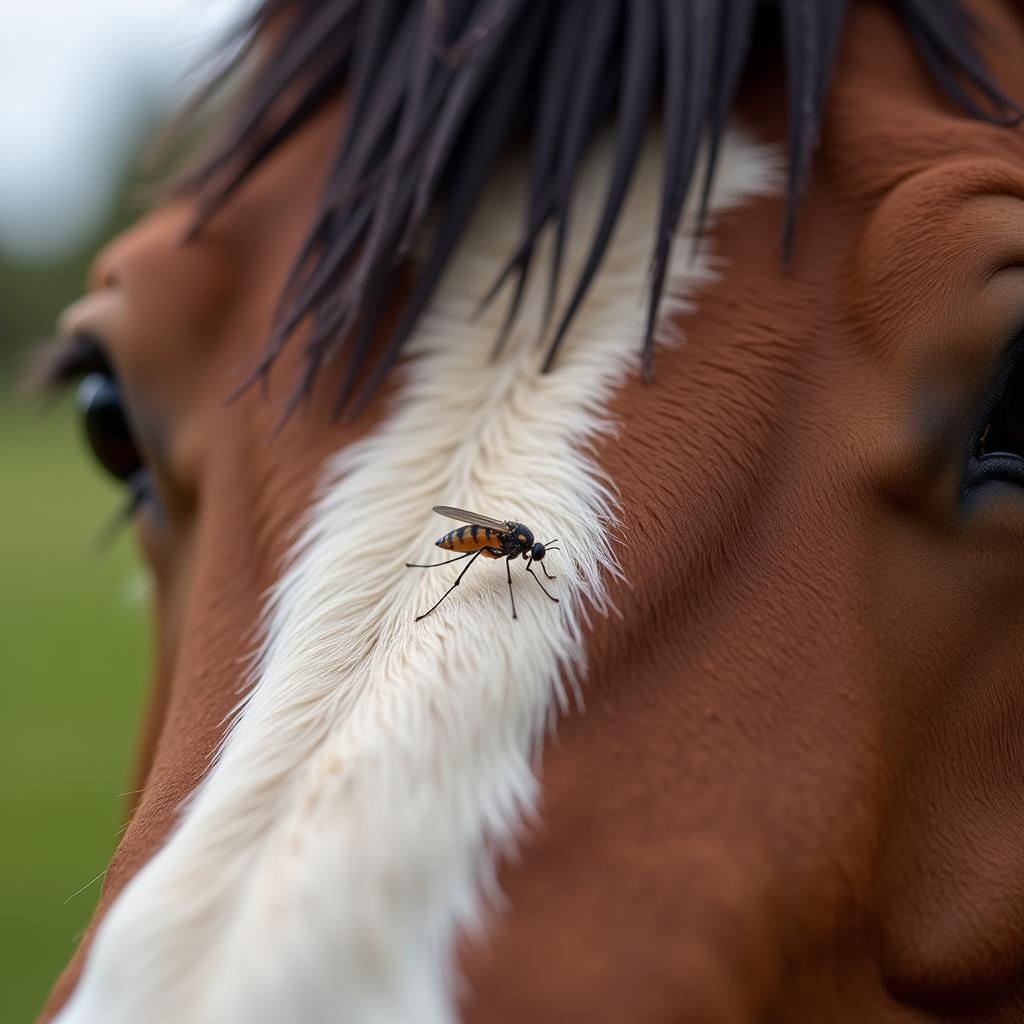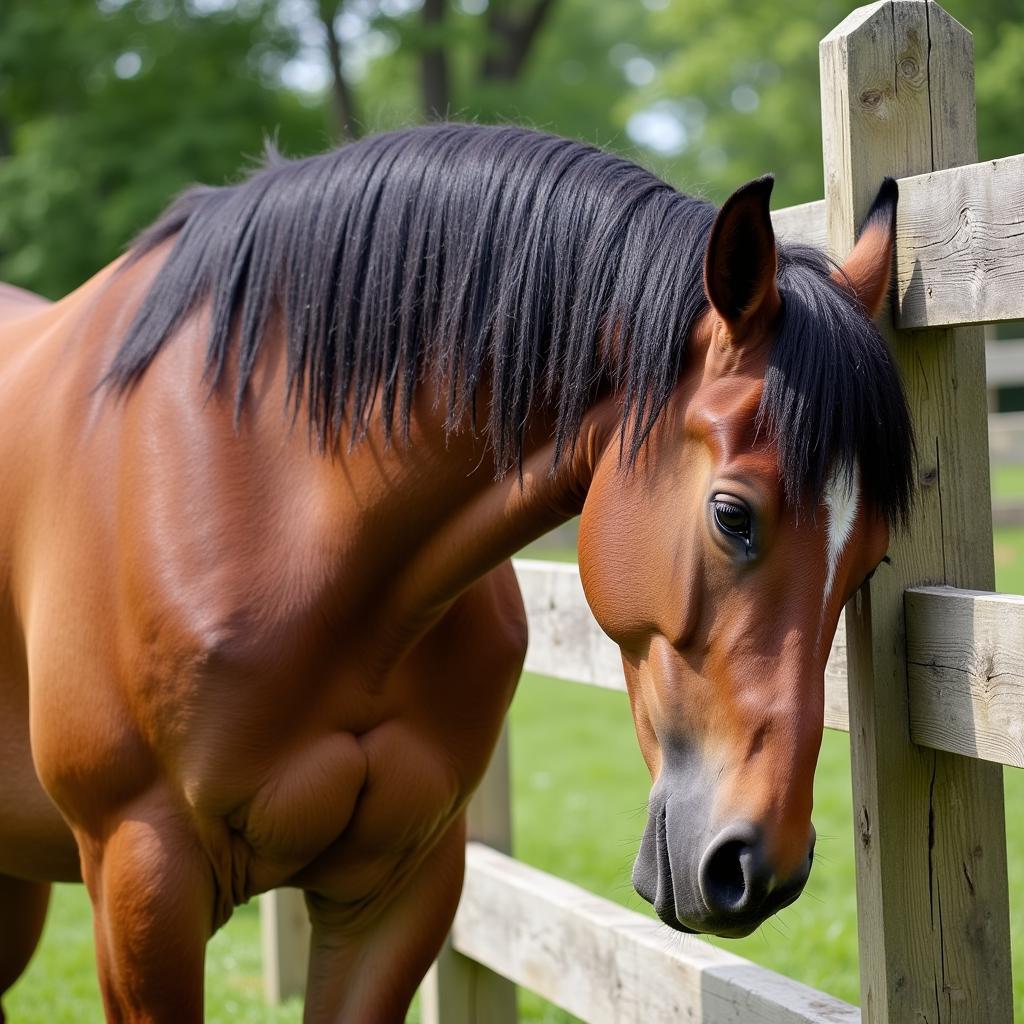The term “Horse Neck Sleazy” might sound unfamiliar, but it likely describes a symptom of a common equine parasite: neck threadworms, scientifically known as Onchocerca cervicalis. While the phrase itself isn’t a recognized medical term, it reflects the common observation of horses rubbing and scratching their mane and neck area due to the irritating presence of these parasites.
This comprehensive guide delves into the intricacies of Onchocerca cervicalis, exploring its life cycle, the symptoms it causes in horses, and most importantly, effective prevention and treatment strategies.
The Life Cycle of Onchocerca Cervicalis: A Closer Look
Understanding the life cycle of Onchocerca cervicalis is crucial for effective prevention. These threadworms rely on a fascinating and complex interplay between horses and tiny biting insects called midges (Culicoides spp.).
-
Microfilariae in the Horse: Adult female Onchocerca cervicalis worms reside in the horse’s connective tissues, particularly around the ligamentum nuchae, which runs along the neck. They produce microscopic offspring called microfilariae that circulate in the horse’s bloodstream.
-
Midges as Vectors: When a midge feeds on an infected horse, it ingests these microfilariae. Inside the midge, the microfilariae develop into infective larvae over several weeks.
-
Transmission to Another Horse: The infected midge, upon biting another horse, deposits these larvae onto the new host’s skin. The larvae then migrate through the bite wound into the horse’s tissues, eventually maturing into adult worms and continuing the cycle.
 Horse Neck Close Up Midge Feeding
Horse Neck Close Up Midge Feeding
Recognizing the Signs: How to Identify Onchocerca Cervicalis in Horses
Onchocerca cervicalis infestations often go unnoticed in their early stages. However, as the worms mature and the horse’s immune response kicks in, a range of symptoms might surface. These can include:
- Itching and Hair Loss: Intense itching, particularly around the mane, withers, and base of the tail, is a common sign. Horses often rub these areas excessively, leading to hair loss and skin irritation. This is likely what the term “horse neck sleazy” attempts to describe.
- Skin Lesions and Nodules: Raised bumps or nodules, often firm to the touch, may appear along the midline of the neck, chest, and belly. These nodules represent the body’s attempt to wall off the adult worms.
- Eye Problems: In some cases, Onchocerca cervicalis microfilariae can migrate to the eyes, causing inflammation (uveitis), corneal opacity, and even blindness.
- Secondary Infections: Constant rubbing due to itching can create open sores and wounds, making the horse susceptible to secondary bacterial or fungal infections.
 Horse Scratching Mane on Fence Post
Horse Scratching Mane on Fence Post
Protecting Your Equine Companion: Effective Prevention and Treatment of Neck Threadworms
While completely eradicating Onchocerca cervicalis can be challenging due to the environmental presence of midges, implementing preventive measures can significantly reduce the risk of infestation.
- Targeted Deworming: Consult your veterinarian to establish an appropriate deworming schedule using macrocyclic lactone anthelmintics. These medications effectively target and kill microfilariae, interrupting the parasite’s life cycle.
- Midge Control: Minimize midge exposure, particularly during peak biting periods, which are typically dawn and dusk.
- Stable Management: Provide adequate stable ventilation and consider using fans to deter midges.
- Fly Sheets and Masks: Employ fly sheets and masks to create a physical barrier against biting insects.
- Repellents: Apply insect repellents containing pyrethrins or permethrin to exposed areas.
- Pasture Management:
- Maintain Cleanliness: Regularly remove manure and soiled bedding to reduce breeding grounds for midges.
- Strategic Grazing: Graze horses at times when midge activity is low, such as midday.
When to Seek Veterinary Care
If you suspect your horse may have Onchocerca cervicalis, consult your veterinarian promptly. They can perform diagnostic tests, such as blood tests or skin biopsies, to confirm the presence of the parasite. Treatment typically involves a combination of deworming medications and supportive care to manage itching and prevent secondary infections.
While “horse neck sleazy” might not be a scientific term, recognizing the symptoms it describes can be crucial in identifying and addressing Onchocerca cervicalis infestation in horses. By understanding this parasite’s life cycle and implementing proactive prevention strategies, you can play a vital role in safeguarding your equine companion’s health and well-being.
Frequently Asked Questions About Onchocerca Cervicalis (Neck Threadworms)
1. Can humans get Onchocerca cervicalis from horses?
No, Onchocerca cervicalis is species-specific, meaning it only infects horses. Humans cannot contract this parasite from infected horses.
2. Is Onchocerca cervicalis contagious between horses?
Onchocerca cervicalis is not directly contagious between horses. Transmission requires the involvement of an infected midge as an intermediate host.
3. What is the best deworming medication for Onchocerca cervicalis?
Consult your veterinarian for guidance on the most appropriate deworming protocol for your horse. Macrocyclic lactone anthelmintics, such as ivermectin and moxidectin, are commonly used to effectively target microfilariae.
4. Can Onchocerca cervicalis be cured?
While complete eradication of Onchocerca cervicalis can be challenging, implementing consistent deworming and midge control measures can effectively manage the parasite and prevent clinical signs.
5. Are there any home remedies for treating Onchocerca cervicalis?
While some home remedies might offer temporary relief from itching, it’s essential to consult your veterinarian for proper diagnosis and treatment. Relying solely on home remedies without veterinary guidance could delay appropriate care and potentially worsen the infestation.
Need More Help?
For personalized advice on horse care, including parasite prevention and management, don’t hesitate to reach out to our experts at Justus Horses USA. Contact us at Phone Number: 0772127271, Email: [email protected] or visit us at QGM2+WX2, Vị Trung, Vị Thuỷ, Hậu Giang, Việt Nam. Our dedicated customer support team is available 24/7 to assist you. You can also check out our other informative articles on horse jump fillers for more equine-related insights.